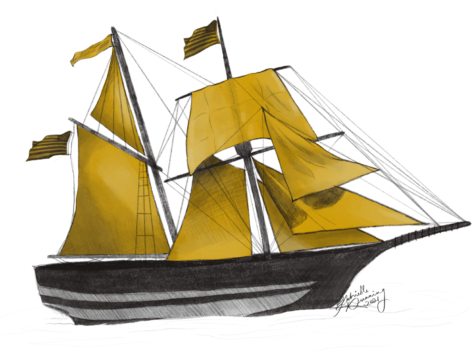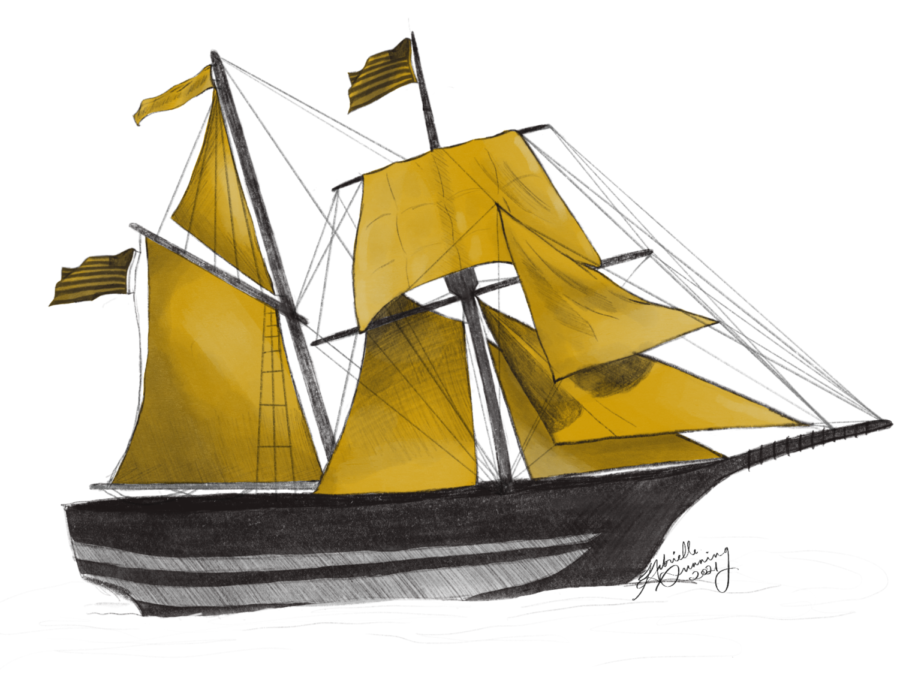Digital drawing of The Amistad by Gabrielle Dunning.
The Amistad Case
In August 1839, a U.S. Brig came across the schooner Amistad full of formerly illegally obtained, enslaved Africans and two Spaniards near the coast of Long Island.
The Amistad

In August 1839, a U.S. Brig (a two-masted, square-rigged ship with an additional gaff sail on the mainmast) came across the schooner (a sailing ship with two or more masts, typically with the foremast smaller than the mainmast, and having gaff-rigged lower masts) Amistad which was full of formerly illegally obtained, enslaved Africans and two Spaniards near the coast of Long Island.
Aboard the Amistad (Spanish for “Friendship”) were Africans who had been trafficked from Mendeland (present-day Sierra Leone) and illegally sold in Havana and the Portuguese slave hunters who had attempted to enslave them. Even though at this point, the United States, Britain, Spain, and misc. European powers had abolished the importation of enslaved people, the Transatlantic slave trade continued.
Spanish plantation owners Pedro Montes and Jose Ruiz purchased 53 enslaved Africans and on June 28, they all set sail for Puerto Principal (present-day Camagüey) but after several days into their voyage, one of the captured Africans – Sengbe Pieh, also known as Joseph Cinque – managed to unshackle himself and his fellow captives. Armed with knives, they seized the Amistad, killing the ship’s captain and cook, who had taunted the captives by telling them that once they arrived at the plantation, they were to be cooked and eaten.
Without navigation skills, the Africans ordered Montez and Ruiz to sail the vessel eastward, back to Africa, but the Spaniards instead sailed through the Caribbean and up the Eastern Coast of the United States. August 26, the US Brig Washington found the ship anchored off of the tip of Long Island to get provisions. The naval officers seized the ship, shackled the Africans, and escorted them to Connecticut, where they would claim salvage rights to the ship and its human cargo.
The Court Case
Cinque and the other African s were charged with murder and imprisoned in New Haven, Connecticut, though these charges were quickly dropped, they remained in prison while the courts went about deciding their legal status, as well as the competing property claims by the officers of Washington, Montes, Ruiz, and the Spanis Government. A group of abolitionists in the north, led by Lewis Tappan, Rev. Joshua Leavitt, and Rev. Simeon Jocelyn, raised money for their legal defense, arguing that they had been illegally captured and imported as slaves, while President Martin Van Buren sought to extradite the Africans to Cuba to pacify Spain.
The Defence team enlisted Josiah Gibbs, a philologist, and Yale alum, to determine the language that the group of Africans spoke; after concluding that they were Mende, Gibbs searched for anyone who recognized the language and found a Mende speaker to interpret for the Africans, allowing them to tell their own story for the first time.
In January 1840, a judge in the U.S. District Court in Hartford ruled the Africans were not Spanish slaves, but had been illegally captured and should be returned to Africa. , After appealing the decision to the Circuit Court, which upheld the lower court’s decision, the U.S. attorney appealed to the U.S. Supreme Court, which was heard in the next year. On March 9, 1841, the Supreme Court ruled 7-1 to uphold lower court’ decision in favor of the Africans of the Amistad. Justice Joseph Story delivered the majority opinion writing that
But the court didn’t require the government to provide funds to return the Africans to their homeland and awarded salvage rights for the ship to the U.S. navy officers who apprehended it. After Van Buren’s successor, John Tyler, refused to pay for their return, abolitionist once again raised funds and in November 1841, Cinque and the other 34 surviving Africans (some died at sea and in prison awaiting trial) sailed, accompanied by several Christian missionaries, to return home.

